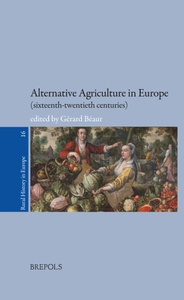RHN 113/2020 | Publication
Gérard Béaur (ed.), Alternative Agriculture in Europe (sixteenth-twentieth centuries) (Rural History in Europe, RURHE; 16), Turnhout: Brepols 2020.
The issue of long-term agricultural transformations remains a hot topic in historiography. The texts of this book intend to take this debate seriously into account by putting several models of alternative crops to facts.
The treatment of long-term agricultural transformation remains a lively topic for historians. Much debate arose when agricultural development patterns were discovered that did without a dominant, production-oriented cereal crop, even when it was accompanied by livestock farming. Joan Thirsk hoped to conclude this debate by putting forward the hypothesis that such “alternative agriculture” was the farmers’ way of responding to the difficulties caused by periods of low agricultural prices. This theory stirred up controversy and arguments both for and against.
The contributions to this volume take this hypothesis seriously and attempt to assess its validity. Examining a large number of “alternative agricultures” over the long term, from the fifteenth to the twentieth century, they discuss the issues encountered in tracing the links between the spread of alternative crops, such as fruits and vegetables, flowers, and industrial crops, and the general economic environment, across a vast swathe of territory stretching from Flanders to Spain and from France, through Italy and Switzerland, as far as Russia.
Source: http://www.brepols.net/
